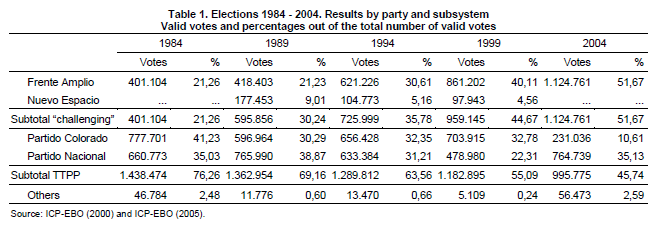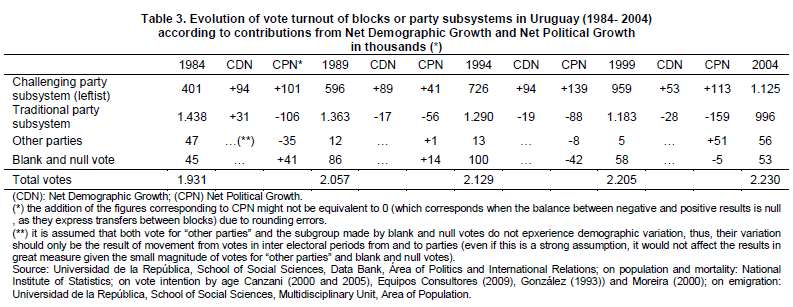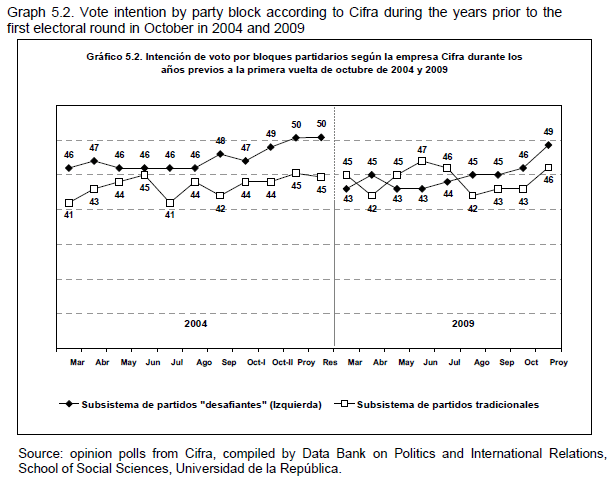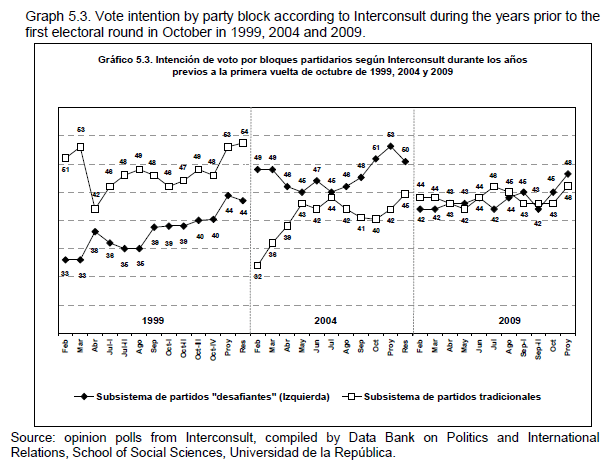Mi SciELO
Revista Uruguaya de Ciencia Política
versión impresa ISSN 0797-9789
Rev.urug.cienc.polít. v.4 n.se Uruguay 2008
Weakening of the demographic effect and consolidation of a new party system: evidence for the 2009 Uruguayan elections
Debilitamiento del efecto demográfico y consolidación de un nuevo sistema de partidos: evidencia de las elecciones 2009 en Uruguay
Gustavo De Armas
Teacher and Researcher from the Department of Political Science, Universidad de la República. gustavodearmas@gmail.com
Translated by Lucía Tiscornia
Translation from Revista Uruguaya de Ciência Política, Montevideo, v.18 n.1, December 2009.
ABSTRACT
Between the elections of 1984 and 2004 the Uruguayan party system experienced a gradual but also deep transformation. The new party system that emerged in 2004, constituted by two large –formal or informal– coalitions (a new two-party system), can be explained by long-term trends (the demographic change of the electorate) and electoral conjunctures. The decrease of Frente Amplio's vote turnout between 2004 and 2009 can be explained by the weakening of the "demographic effect" and by the relatively significant transfer of votes, from the left coalition to the other parties. Despite those changes, the recent election seems to have consolidated the party system that emerged from the previous election, which is likely to remain over the next years.
Key words: Party System, Elections, Electoral Behavior, Frente Amplio
RESUMEN
El sistema de partidos uruguayo experimentó entre las elecciones de 1984 y 2004 una gradual pero también profunda transformación. El nuevo sistema de partidos que emergió en 2004, constituido por dos grandes –formales o informales– coaliciones (un nuevo bipartidismo), puede ser explicado por tendencias de largo plazo (el cambio demográfico del electorado) y coyunturas electorales. La disminución del porcentaje de votos por el Frente Amplio entre 2004 y 2009 puede ser explicada por el debilitamiento del "efecto demográfico" y por la transferencia de votos, relativamente significativa, desde la coalición de izquierda hacia los otros partidos. Pese a esos cambios, la reciente elección habría consolidado el sistema de partidos que emergió de la anterior elección, el cual parece ser el más probable en los próximos años.
Palabras clave: Sistema de partidos, Elecciones, Comportamiento electoral, Frente Amplio
Introduction
Since political science was born, voters' behavior has been one of its main subject matters. Throughout decades, American political science and electoral sociology have accumulated theoretical knowledge and empirical evidence with regard to the determining, or conditioning, factors of electoral behavior. Besides, the study of electoral behavior and proselytizer campaigns is naturally intertwined with enquiries on public opinion. Explaining voters' preferences or loyalties, necessarily implies understanding how public opinion is built. Likewise, examining electors' behavior (demand) and candidates and parties' action (supply) supposes scrutinizing the influence that electoral rules and strategies of political communication might have on electoral results.
Until two decades ago, two main interpretations regarding the understanding of electoral behavior debated in political science: some views that minimized the influence that electoral campaigns have on voters, focusing on sociodemographic variables; on the other hand, the scholars of "party identification" focused on political variables: among others, citizens' attitudes, preferences and evaluations.
Over the last twenty or thirty years, other perspectives on electoral behavior have emerged, which turns the analysis even more complex. The theories on "pocket vote" (Erikson, MacKuen and Stimson, 2000) try to explain voters' decision from their judgment and evaluations regarding the economic performance and their individual or collective situation; there are also approaches that focus on the study of the impact of electoral campaigns in a context of growing – and maybe irreversible – mass-mediatization of politics. (Sartori, 1998).
The explanation of electoral behavior in a specific historical and spatial context can be considered, beyond its contribution to political science, a specific subject of interest. Advancing in an explanation of voters' behavior acquires an added value if it allows, together with other inputs, descriptions and explanations of the electoral evolution of parties and, thus, of the changes in the party system. In a poliarchy, the transformation of the party system (for example, the transition experienced by Uruguay from its foundational two-party system to a "moderate pluralism", which spins around a new bipolar dynamics) can only be understood by examining the relationship between the electoral demand and supply.
1. The transformation of the party system: from democratic reestablishment in 1984 to the electoral triumph of Frente Amplio in 2004
Between the elections of 1984 and 2004 the Uruguayan party experienced one of the most significant changes in its history, at least since the configuration of the poliarchic system at the beginning of the last century: we are referring to the transition from a foundational two-party system, constituted by the long-lived Partido Colorado (PC) and Partido Nacional (PN), to a new two-party system (or a status between a "moderate pluralism" and a two-party system as the one described by Sartori1), involving the competition between Frente Amplio (FA) and the traditional parties. This transition began, of course, long before the national election of 1984; the gradual and sustained change from the old to the new two-party system begins with the results of 1971, when the smaller parties, or "parties of ideas", coalitioned within the FA and surpassed by far their historical turnout, becoming the second political party in Montevideo, after PC, with 30.14% of valid votes.
The 1984 election, the first after eleven years of an authoritarian regime, reproduced, with some nuances, the electoral map prior to the coup d'etat in 1973. The results of 1984 confirmed the substitution of the Uruguayan traditional two-party system for a moderate pluralist system. From that moment, until the 2004 election, the Uruguayan political system underwent a gradual and sustained transformation. As Buquet (2005) points out, the 2004 election seems to have given an end to a long cycle of changes, establishing a new two-party map. Between the 1984 and 2004 election the addition of the two traditional parties' vote turnout was reduced in 30 points compared to the total amount of valid votes: this percentage was captured by a subsystem composed by "challenging parties" (González and Queirolo 2000).
The configuration of this new map of parties was the result of the sustained growth of the subsystem composed of the leftist parties, the consequent reduction of the traditional parties' group and the dilution of the frontiers that used to clearly separate "blancos" and "colorados". In that period, the reproduction of loyalties, identifications and preferences towards parties stopped operating following the secular dialectics between "blancos" and "colorados" to gravitate to a new tension: competition between the Left and traditional parties. In that sense, the empirical evidence allows to show the extent to which, over the last years, "blanco" and "colorado" voters became used to moving from one party label to another at a low cost. This way, the dynamics of competition and production assumed by the political system and the party subsystem were those typical of a two-party system. Political parties and voters began to behave according to two fields of party affinity: traditional parties and "challenging" parties. The constitutional reform of 1996 – in particular, the incorporation of ballotage for the presidential election – contributed, in some way, to consolidate this new kind of competition.
To understand the evolution of electoral behavior between 1984 and 2004 – especially since the mid-last decade until 2004 – it is useful to analyze the party system beyond party limits as a system composed of two fields or blocks: the "subsystem of "traditional parties" and the "subsystem of challenging parties".
The fact that competition for the electorate operates first and foremost between the two blocks of parties and then within them, is one of the indicative signs of the extent to which the party system has functioned as two-party since 1989, despite its format or the number of parties. In that sense, it is necessary to point out that PC's abrupt fall between the elections of 1999 and 2004 (473 thousand votes that implied a decrease of 32.78% of valid votes to 10.61%) was accompanied by a significant growth of PN (286 thousand more votes that represented a jump from 22.31% to 35.13%). Analyzing the electoral performance of traditional parties as independent units – at least from the voters' perspective2– could lead to a series of errors. Considering that traditional parties lost, as a block, around 160 thousand votes between the elections of 1999 and 2004 – that is, a decrease of 9.35% with regard to the total of valid votes – and that the movement of votes between the "traditional" and "challenging" subsystems has been relatively low and almost exclusively beneficial for the latter, the significant growth of PN in the election of 2004 could only be explained as a result of a transfer of votes between the traditional parties. Transfer of votes between the traditional parties, on the one hand, and between fractions within FA (Buquet and De Armas 2004: 121) on the other, illustrates the extent to which the Uruguayan party system has assumed a new bipolar dynamics – despite its physiognomy.
Changes in voters' preferences are the basis of this deep transformation of the party system and, at the same time, one of its main effects or results. In this context, it is necessary to build a descriptive and explanatory narrative about the changes that have operated on the electorate and, thus, in the party system, since the reestablishment of democracy: in particular, the growth of the Left. Explaining such growth requires verifying the different hypotheses that political science and electoral sociology have built to account for the transformation of the party system. Likewise, this discourse allows the creation of different possible scenarios that might emerge from the 2009-2010 electoral cycle.
1. Dissecting the "demographic explanation" of the growth of the Left
The growth of "challenging" parties between 1984 and 2004 has generated different intents of explanations – or at least descriptions – among Uruguayan political scientists and sociologists. While the growth in the percentage of votes in the challenging subsystem over the total of valid votes was constant in this period (9% between 1984 and 1989, 5.5% between 1989 and 1994, 8.9% between 1994 and 1999, and 7% between 1999 and 2004), registering a relatively low coefficient of variation in the four periods, it seems clear that the evolution of the Left cannot be the result of favorable junctures or citizenship's erratic movements.
From the field of electoral sociology, some researchers (Aguiar 2000; Canzani 2000; González and Queirolo 2000) have stated that the growth of the Left could be explained by the demographic renewal of the electorate, thus building what we have called the "demographic model" (Buquet and De Armas 2004). The demographic thesis has been exposed synthetically by Aguiar (2000: 20-21):
"... in an electorate divided according to age, even if nobody changes their opinion, the mere course of time implies the growth of the parties with greater relative weight among the younger voters. That way, if the cleavage operated with clarity since 1971 and continued operating over time, the EPFA would continuously grow even if no voter of foundational parties changed their mind (...) in the period 1971-1999, the demographic effect accounts for proportions close to 1% a year (...) it can be stated that in 2004 the EPFA's electoral basis will rise to approximately 5% more as a result of this demographic effect."
Taking that thesis as a starting point, Canzani states (2000: 240-241):
"... the mortality registered over a certain period is more likely to affect traditional parties more – because they lose "older" votes – than non traditional parties. How much of the change in the electoral weight of parties can be explained by the demographic factor? There is not any precise estimation, though its magnitude is far from being negligible, as in an electoral period of five years at least 170,000 people are out of the voter registration list –due to mortality– which in these years has represented a proportion of between 7% and 8% of the total of voters."
Finally, Gonzalez and Queirolo (2000: 303) argue:
"all polls have shown that over the last years there has been a strong association between age and "challenging" vote. This vote increases systematically while age decreases; the younger vote the "challenging" the most. Moreover, the slopes of the regression lines show that both kinds of votes (the challenging, that increases, and the traditional, that decreases) should change, on average, around 1.3% a year. This value is close to the one that could be expected (considering the relatively low population growth rate in Uruguay) for a process of change of the party system closely related to the electorate's generational renewal, and is therefore consistent with the results of the polls. Whatever the substantive reasons that explain it may be, this generational feature gives a vigorous inertia to the party system's process of change, because "generational learning" crystallized at young age can then be modified, but those modifications are normally slow and difficult."
In fact, it is easy to realize there is a robust relationship between age and vote in the Uruguayan electoral body, at least since objective information about public opinion's behavior is available. As shown on the table below (and despite the limited secondary information for some elections, as well as the difficulties to generalize results from the relatively small samples that result from the analysis of information by age cohorts between 1984 and 2009 new voters' preference for the Left has remained constant, and so has the overrepresentation of vote intention to traditional parties among older voters. Of course, when new voters who sympathize with the Left are incorporated to the voter registration list, the weight of the left in the vote intention of adult and elderly voters grew almost inevitably (multiplying by 4,7 among the latter). The growth in vote intention for the Left among adult voters (between 30 and 59 years of age) and elderly voters (60 or more years old) over the last decades reduced the Left's over representation among younger voters (18 to 29 years of age), while the magnitude of the "demographic effect" is reduced in the long term.
As shown, the hypothesis on the demographic growth of the Left is widely shared among social scientists in Uruguay.5 However, the "demographic explanation" sometimes seems to have certain teleological character (De Armas 2000) leaving small room for political maneuvers, electoral competition or even for extra political variables that could explain the evolution of the party system. Another weakness that could be attributed to the demographic argument is its descriptiveness: somehow lacking more solid theoretical ambition. In general, national sociology has examined the electoral growth of the Left based on the changes in the electoral mass, without worrying about the changes in party supply or the dynamics of the competition among parties. It could be stated that sociology has studied the electoral growth of the Left – and drawn conclusions about the changes in the party system – as if voters' preferences were given, relatively independent from political actors and, therefore, as if everything was about the mere renewal of parties' electoral stock. On the other hand, political science has analyzed the electoral growth of the Left focusing on the diverse mutations experienced by the electoral supply: the long process of "nationalization" of the Left (Lanzaro 2004), the coming of a "progressive era" as a result of its programmatic and ideological modernization (Garcé and Yaffé 2004), the FA move to the center of the ideological spectrum (Buquet and De Armas 2004; Buquet and Selios 2004) or voters' movement towards the Left (Moreira 2004). Some sort of obliviousness with regard to politics could be attributable to the national sociology when explaining the electoral growth of the Left, also, the local political science could be questioned for not having examined more in depth the transformations suffered by the electoral body over this period.
How has the demographic effect operated? During the 5 years that mediate between elections young people become part of the electoral body who, according to their age, will vote for the first time (being, at the time of the election, between 18 to 22 years old). At the same time, other citizens who had voted in the previous election, will be out of the electoral body, basically due to two reasons: because they die or because they emigrate in the period between elections. Consequently, if we can estimate, the number of new young voters (18 to 22 years old), the number of voters who die (60 or more years old, or younger) and the number of voters who emigrate, for every period between elections since the reestablishment of democracy, we can then calculate the "net demographic growth" (CDN) of the electoral body and of each of the two main party blocks: the Left and traditional parties. Assignment of vote intention for both party blocks among new voters, those who die (elderly or adults) and those who emigrate (basically youngsters and adults) can be made based on the analysis of age cohorts for such variable provided by opinion polls.
This way we can estimate that demographic renewal of the electorate explains the origin of approximately 45.6% of the 724 thousand votes that increased vote turnout in the "challenging" party subsystem between 1984 and 2004. As a result, it is necessary to elaborate some hypotheses to explain the remaining growth (those 394 thousand votes of net political growth –CPN– accumulated in those years). Those hypotheses would allow understanding why hundreds of thousands of "blanco" and "colorado" voters emigrated to the Left between 1984 and 2004, allowing it to reach Office with 50,45% of votes and 51,7% of valid votes. Likewise, we have to establish hypotheses to explain – and not merely to describe – the demographic model or argument. For instance, hypotheses with respect to the relationship between age and vote, or regarding the greater capacity of leftist families to transfer electoral preferences than "blanco" or "colorado".
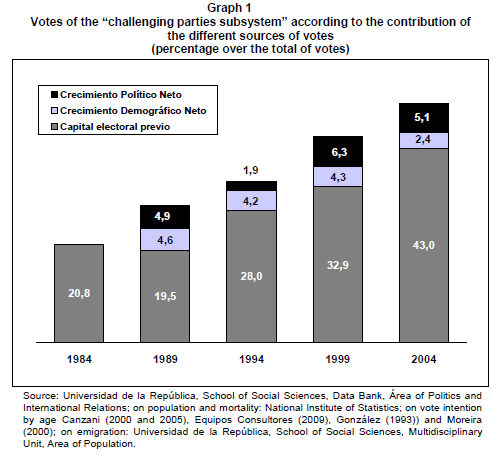
Even if the Left has been able to capture a significant percentage of the new voters accumulated in ever inter-electoral period, since 1984, its growth among older voters in the last 25 years (people older than 60 years old, which explains more than 80% deaths in that period) determines that the demographic gains be reduced in relation to the total of votes. Despite the demographic effect still operates, its magnitude will tend to diminish with time. In addition, in some periods – particularly in the 1999 and 2004 elections, owing to the economic crisis of 2002 – the country has suffered important emigration.6 To summarize, the demographic effect does not allow explaining the whole process of growth of the Left between 1984 and 2004 (in fact, it explains approximately half of such growth); at the same time, its extent will be progressively reduced. Consequently, it is necessary to incorporate other variables to describe and explain more in detail the Left's growth: particularly, the changes in the party system and the impact of some political-electoral junctures, where an increase greater than demographic growth was registered (growth rate of approximately 1% annually, referred to by Aguiar, Canzani, González and Queirolo). As Buquet and De Armas point out (2004: 128):
"The fact that a great deal of the electoral growth of the Left responds to strctly political factors – the "expulsion" of colorado or nacionalista7 vters to the left and the corresponding ideological and programmatic moderation of challenging parties (...) – does not imply ignoring or underestimating the "demographic effect"; on the contrary, the identification of such political factors aims at complementing and completing such widespread sociodemographic explanation."
To identify the determining of electoral "migration" from the "traditional" to the "challenging" subsystem, it is relevant to analyze the beginning of the process of transition in the party system: the election of 1971. Until the election of 1971 the addition of all "challenging" parties had always been around 10% of the electorate. In 1971, with the creation of FA, the "challenging" party subsystem reaches 18,28% of the total valid votes, which represented a 90% increase in comparison with smaller parties' vote turnout in 1966 (9,62%). This increase matches a significant fall of PC. Between the elections of 1958 and 1966 – the period of "competitive two-party system" according to González (1993)– the subsystem of traditional parties had, on average, 89.4% of the total valid votes. Between the elections of 1966 and 1971, the PC clearly reduced its vote turnout, from 49,33% to 40,96% of total valid votes. In those five years there was a movement towards the Right of the ideological and programmatic supply of the PC, parallel to the moderation of the leftist supply with the creation of FA – understood in terms of "nationalization" and institutionalization – where a group of center-left actors from traditional parties played a key role. It could be stated that the election of 1971 register the first big increase, in terms of vote turnout, in the "challenging" party subsystem, with consequent fall in the "traditional" block, in a context of voters' expulsion and redefinition of the programmatic and ideological supply of one of the traditional parties and the "challenging" subsystem. After the 1984 elections –when the electoral map prior to the coup d'etat was almost reproduced–, begins a sustained growth of the Left, which the demographic model has tried to explain. However, when reviewing the electoral data from 1984 to 2004, we noticed that, with the exception of 1994, a relevant fraction of the growth of the Left owed to incoming voters from the traditional parties. As we have stated (Buquet and De Armas 2004: 130):
"When analyzing the events prior to the elections of 1971, 1989 and 1999 (the events occured within one of the two traditional parties), that is, when the greatest electoral peaks of the Left took place, a regularity is observed: if any of the traditional parties narrows its ideological supply there is a voters drain to the "challenging" party subsystem, while the Left moderates its ideological positions and its electoral platform."
Finally, between 1999 and 2004 there is a relevant reduction in the percentage of votes in the "traditional" subsystem over the total of valid votes (from 55.09% to 45.74%), matching a 7% increase in vote turnout for the "challenging" block and 2.35% for smaller parties (51 thousand more votes than in 1999). This phenomenon is basically explained by the vote turnout of Partido Independiente (PI). Beyond the particular analysis of the election of 2004 and the evolution since then, empirical evidence leads to questioning the capacity of the demographic model to account for all the changes in the electoral map; at the same time, it allows us to elaborate some hypotheses on the political factors (inter-party competition scenarios, ideological evolution, programmatic supply of parties, etc.) which would have determined the electoral peaks of the Left and, therefore, the transformation in the shape of the party system.
2. Permanences and novelties in the election of 2009
Although the "demographic effect" still operated after the election of 2004, its magnitude had decreased in comparison to the previous inter-electoral periods (with the exception of the period 1999-2004 when the CDN was lesser due to the important emigartion registered in those years). As mentioned before, this tendency owes to the increase in votes for FA among the older voters: while in the electoral campaign of 1984, broadly speaking, only one out of ten 60 or more years old voters stated they would vote for FA, in the previous campaign and in the current one, practically four out of ten voters were inclined to the Left. Though the FA still collects most of the new votes – and in general of the younger voters – the loss of adult and elderly voters, owing to the renewal of the electorate, will probably determine a greater reduction in CD in the following years.
Considering that between the 2004 and 2009 election there were approximately 244 thousand new voters (between 18 and 22 years old), that 148 thousand voters died (of which more than 80% correspond to the group of people over 60 years old) and that around 32 thousand people left the country in that period –who would have certainly voted if they had not left – the Left's CDN could be estimated in a range of 80 to 85 thousand votes (3.6% of the total votes cast on 25 October 20098) and the demographic loss of the block of traditional parties in a range of 10 to 15 thousand votes. If the FA had kept, in 2009, the votes it received in the previous election (with the exception of those who died or emigrated in the last five years) then, it should have reached approximately 52.5% of the total votes cast and 54% of the valid votes, and its CDN can be estimated in 3.6% over the last electoral period.9 10
The votes obtained by FA (47.97% of the total votes cast) implies, consequently, a slight decrease in its vote turnout in 2004. In other words, the Left was not able to keep a group of voters that represented around 4% of the total votes cast in the last election. Naturally, this conclusion can only be supported if the hypothesis of the "demographic effect" is assumed as valid; which is agreed by academia and supported by the estimation on its magnitude over the last inter-electoral period.
When examining the results of the opinion polls carried out during 1999 and 2004 (until the elections in October in each year) as well as the results published since the beginning of 2009 until the recent election in October, some changes connected with voters' behavior are noticeable.
The series of polls carried out by Equipos Consultores shows that the Left had an vote intention of 47.5% on average, From february to October 2004. Whereas the average registered between February and October 2009 reached 44.2%. Consultant Cifra's series show that between March and October 2004, the FA had an average 46.8% vote intention, while between March and October 2009, it was 44.3%. The conclusions reached when analyzing the data from Interconsult are similar: between February and October 2004 the Left had an average vote intention of 47.3% and between February and October 2009, of 43.2%. Finally, according to Radar, the FA had an average of 49.8% vote intention between February and October 2004, whereas between March and October 2009, it was 44,7%. To summarize, if 2004 and 2009 results – provided by four out of the five main opinion polls consultants in Uruguay (see Graphs in the Annex) – it is noticeable that FA's vote intention decreased between those elections – during the electoral year – between 2.5 percentage points (Cifra) and 5.1% (Radar).

The data presented (the estimation in magnitude of the FA's CDN between 2004 and 2009 and the comparison between its vote intention over the years prior to the last two elections) lead to the conclusion that, highly likely on the past 25 October, the leftist party subsystem (even adding up the FA and "Asamblea Popular"11) registered a decrease in vote turnout due to political causes (and not demographic) for the first time since the reestablishment of democracy. That is, it registered a negative difference between the voters who came from other parties or options (voters that in 2004 voted for PC, PI, PN, blank or null) and those who emigrated from FA to them. Even if the Left had surpassed absolute majority of the votes cast in the first round in 2009 for some decimals, it could have been stated the same conclusion, or at least that it registered no political growth.
Of course, the votes obtained by FA in the last election (47.97% of the total votes cast), or by the whole block of leftist parties (48.64%), could not be categorized as unsatisfactory in political terms, nor could it be evaluated – in political science terms – as a significant reduction of the Left's vote turnout (let alone as an indicator of voters' ideological movement). International empirical evidence shows that even governments with very good performances – at least when evaluated from the perspective of conventional economic indicators and followed by indexes of approval of the government's performance or of the President's popularity– can wear away in the electoral arena. In that sense, it is worth noticing that between 1984 and 2004 traditional parties suffered significant losses of votes in almost all relevant elections after their respective periods in Office: the PC between 1984 and 1989, and, especially, between 1999 and 200412; the PN between 1989 and 1994. If we analyze party subsystems the losses were registered in the four interelectoral periods comprised in these twenty years.
Besides, micro data analysis of opinion polls (that is, surveyees' political and sociodemographic profile) shows that the Left's basic electorate isa round 40% of the total electoral body, as well as a group of voters – 20 to 30 percentage points– that could be catalogued as "independent", despite their affinity – not very intense – towards the party blocks. It is worth remembering that in the election of 2004 the Left received more than 100 thousand more voters who, in 1999, had voted – almost all of them – traditional parties. Those voters – and maybe a bigger group – are a segment in dispute between the two party blocks. As a consequence, their migration from one block to the other is likely. In that sense, it is inappropriate to state that these migrations constitute electoral losses, as voters who migrate are not part of the basic electorate of any of the two blocks.
3. Tentative hypotheses on the results of the october elections
To build some tentative hypotheses about the explanatory factors of FA's electoral performance in the election of October 2009, it is necessary to consider the existing theoretical perspectives; one of the strongest approaches in the last years is the one that seeks to explain electoral behavior by analyzing voters' perceptions and evaluations with regard to economy and government's performance: evaluations on economic situation and its recent evolution, trust in the future, approval of governmental performance, among others.
In that sense, the data presented in the graphs below show that the "objective" performance of the economy in the last years has been extremely positive. It is particularly relevant to examine two basic economic variables, whose behavior could indeed be translated into the status of citizens' opinion: the evolution of households' real income – not GDP or other macro variables referring to the level of economic activity – and unemployment rate. As shown in Graph 3, regarding households' real income, there is a cumulative increase of 35% between the first quarters of 2005 and 2009; at the same time, between the first quarter of 2005 and April-June of 2009 there is a clear tendency towards the reduction of open unemployment rate, reaching the lowest values of the last decades.
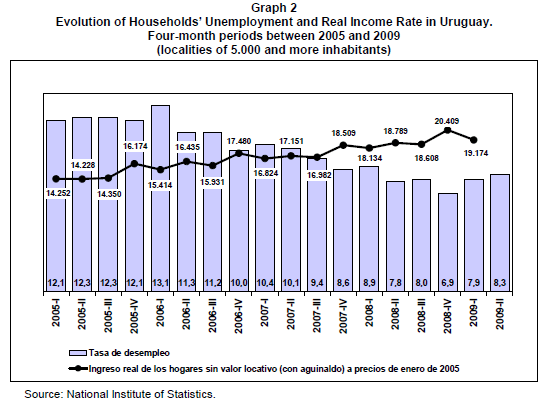
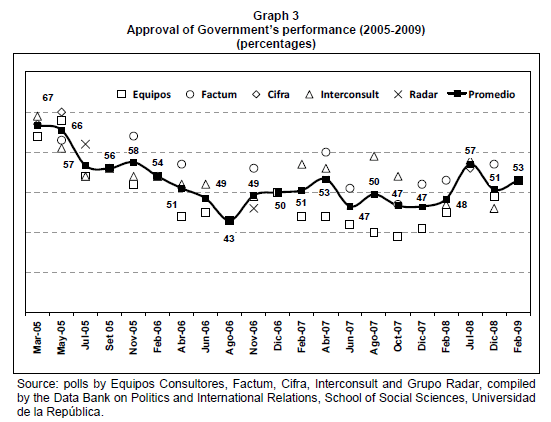
Besides, when analyzing the rates of National Government's approval – particularly, when analyzing the acceptance of the President's performance or his level of popularity – the evidence shows that public opinion support for FA's performance has been, on average, around 50% or above, between March 2005 and February 2009 (particularly in 2005).
Although the levels of approval of a Government can surpass vote intention for the party in Office, it is worth asking about the gap present between the current administration's level of approval and FA's vote intention – and finally its vote turnout– not to mention the distance between the latter and the President's popularity rates or positive image. Indeed, it could be stated – correctly – that voters, when choosing, vote candidates and parties whose performance will materialize in the future, independently from their assessment of the current administration. That is when all parties' electoral supplies come to play: their programs, impacts of the electoral campaign, even electoral communication and publicity (beyond their meager impact in Uruguay).
The last inter electoral period registered a tendency towards the fall or reduction in FA's vote intention, since the beginning of 2006 until the last quarter of 2007, then initiating a recovery phase (Graph 5). This fact allows, up to a certain extent, discarding or at least relativize the hypotheses that seek to explain the reduction of FA's vote intention by, for instance, the characteristics of its internal competition (which definitely had an impact on PC's final vote turnout in 1989 or PN in 1999) or its programmatic or electoral supply towards the first round in presidential elections. In fact, during 2009 – even before – a sustained tendency towards an increase of vote intention for FA is verified; however, it was insufficient to overcome the fall registered between 2006 and mid- 2007.
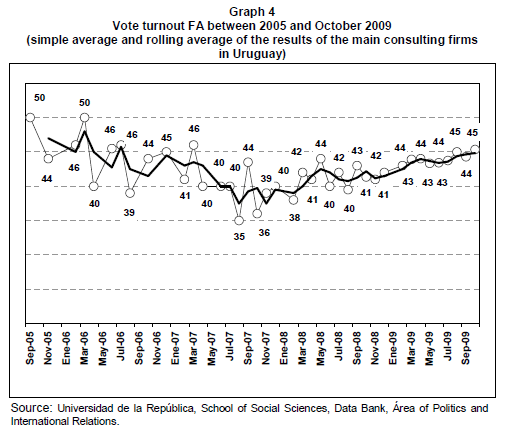
The different hypotheses that could be built to explain the slight reduction of FA's vote turnout – or the difficulty to keep part of it – between 2004 and 200913, have to bear in mind the evolution of vote intention over the last inter-electoral period.
4. Future Scenarios
The results of the last national election have confirmed the new format of the Uruguayan party system as "moderate pluralist", as well as its bipolar dynamics between the Left and traditional parties. At the same time, it reaffirms the existence of a segment of the electorate (mainly the center) that can migrate between blocks from one election to the following without major difficulties. Although the demographic effect will probably keep operating for some more years (though decreasingly) it is clear that the performance of the two party blocks will increasingly depend on their capacity to generate adhesion among those nomad voters, that is, on their capacity to grow "politically". Therefore, their efforts should be directed – among other objectives – to capturing those mobile voters' support, thus building attractive offers beyond their captive electorates.
Those electors who voted for FA in October 2004 and did not do it in the last election14 were distributed, almost entirely, between options placed to its right (traditional parties and PI) independently from their position of center-left, center or center – right, and an option placed to its left (AP).15 In other words, those voters that the FA could not keep emigrated either through the left or the center to other parties. This is one of the challenges the FA will face in the coming years: having to avoid losing votes through the left and the center at the same time. Movement towards one of these two flanks (center or more radical left) could lead to a similar – or even greater – loss by the other one. Though it could be stated that the frontier to prioritize or to protect is the limit with PI and the traditional parties (that is, the center of the ideological spectrum) as losses through that flank turn into gains for the other party block; movement towards parties placed on FA's left (such as AP on the last election) also need to be considered, as they might reduce the possibility of having the majority in Parliament.16 To summarize, the question is how much ideological amplitude admits a political party in our party system under the current rules. Is it possible for a single party – despite having a structure of coalition, thus having different fractions – to comprise during several elections all the voters who identify themselves ideologically as leftist and the majority of those from positions closer to the center (between 50 and 60% of the electorate)?
Beyond the debate on the explanatory factors of the slight reduction in the Left's vote turnout in 2009, and the challenges it will face in the following elections to keep those votes in dispute with other parties, its recent electoral performance (it is the second consecutive time it reaches or surpasses absolute majority of seats in both Chambers) and the likely persistence of the "demographic effect" for some years opens up the discussion on the possibility that the Uruguayan party system is close to a format of "dominant party" system (Sartori 1992).
As shown in the table below, it is necessary to go back sixty years in Uruguay's political history (to the "neobatllismo") to find that the most voted party reaches or exceeds absolute majority in seats in the Senators' Chamber over several consecutive legislatures (four between 1943 and 1959, which turned the system to "dominant"). If the FA's candidate is elected President after he ballotage on 29 November, the next legislature will be the second where the President's party reaches or is beyond absolute majority in both Chambers.17 If the contrary happens, the President's party will not have absolute majority, thus interrupting a new cycle towards a "dominant party" system.
Independently from what happens in the ballotage on 29 November, and from the transformations the Uruguayan political system may go through in the next five years, the recent legislative election shows the consolidation of a moderate party system with a bipolar logic emerging from the election of 2004. At the same time, it confirms the existence of an area of electoral dispute between the two party blocks (the Left and traditional parties) composed by voters in the center that can migrate – and they have proved it – from one block to another between elections. This seems to be the most likely party landscape for the coming years.
5. Reference
Aguiar, César (2000): "la Historia y la historia: Opinión Pública y opinión pública en el Uruguay", Revista Prisma N° 15, Universidad Católica del Uruguay, Montevideo.
Buquet, Daniel (2004): capítulo sobre Uruguay en Public Opinion and Polling Around the World. A Historical Encyclopedia, Geer, J. (editor), Santa Barbara, California.
Buquet, Daniel (2005): "Elecciones uruguayas 2004-2005: De la vieja oposición a la nueva mayoría", en Buquet, Daniel (coord.), Las claves del cambio. Ciclo electoral y nuevo gobierno 2004/2005, EBO – instituto de Ciencia Política, Montevideo.
Buquet, Daniel and De Armas, Gustavo (2004): "La evolución electoral de la izquierda: crecimiento demográfico y moderación ideológica", en Lanzaro, Jorge (coord.), La izquierda uruguaya entre la oposición y el gobierno, Ed. Fin de Siglo, Instituto de Ciencia Política, Montevideo.
Campbell, A., Converse, P., Miller, W. and Stokes, D. (1960): The American Voter, University of Michigan Press.
Canzani, Agustín (2000): "Mensaje en una botella. Analizando las elecciones de 1999/2000", en Elecciones 1999/2000, Ediciones de la Banda Oriental, Montevideo.
Canzani, Agustín (2005): "Cómo llegar a buen puerto: Un análisis desde la opinión pública de la trayectoria electoral del EPFA", in Buquet, Daniel (coord.), Las claves del cambio. Ciclo electoral y nuevo gobierno 2004/2005, EBO – instituto de Ciencia Política, Montevideo.
Crespo, Ismael (2004-2002): Las campañas electorales y sus efectos en la decisión de voto, Vol. I, II y III, Ed. Tirant lo Blanch, Valencia.
De Armas, Gustavo (2005): "Autopsia de los votantes: Los efectos de la campaña electoral en la decisión electoral", in Buquet, Daniel (coord.), Las claves del cambio. Ciclo electoral y nuevo gobierno 2004/2005, EBO – instituto de Ciencia Política, Montevideo.
De Armas, Gustavo (2000): "El crecimiento electoral de la izquierda y las teleologías demográficas (III): Epílogo", Revista Posdata, Número 276, Montevideo, 14 de enero.
De Armas, Gustavo (1999): "El crecimiento electoral de la izquierda y las teleologías demográficas (II)", Revista Posdata, Número 274, Montevideo, 30 de diciembre.
De Armas, Gustavo (1999): "El crecimiento electoral de la izquierda y las teleologías demográficas (I)", Revista Posdata, Número 272, Montevideo, 17 de diciembre.
González, Luis Eduardo (1993): Estructuras políticas y democracia en Uruguay, Instituto de Ciencia Política, Colección Torre de Babel, Ed. FCU, Montevideo.
González, Luis Eduardo and Queirolo, Rosario (2000): "Las elecciones nacionales del 2004: Posibles escenarios", in Elecciones 1999/2000, Instituto de Ciencia Política, EBO, Montevideo.
Lanzaro, Jorge (2004): "La izquierda se acerca a los uruguayos y los uruguayos se acercan a la izquierda. Claves de desrrollo del Frente Amplio" , in Lanzaro (coord.) La izquierda uruguaya entre la oposición y el gobierno, Ed. Fin de Siglo, Instituto de Ciencia Política, Montevideo.
Luna, Juan Pablo (2002): "¿Pesimismo estructural o voto económico? Macropolitics en Uruguay", Revista Uruguaya de Ciencia Política, Nº 13, Ediciones de la Banda Oriental, Montevideo.
Mieres, Pablo (1988): ¿Cómo votan los uruguayos? Las elecciones de 1984, CLAEH, Ediciones De la Banda Oriental, Montevideo.
Mieres, Pablo (1994): El voto en el Uruguay de fin de siglo, Ed. Fin de Siglo, Montevideo.
Mieres, Pablo (1997): "Intermediación política y cambio electoral: algunas líneas de interpretación", en Cuadernos del CLAEH, N° 78-79, Montevideo
Monestier, Felipe (1999): "Partidos por dentro: la fraccionalización de los partidos políticos en el Uruguay (1954-1994)", in González, Luis Eduardo et.al., Los partidos políticos uruguayos en tiempos de cambio, Ed. FCU – UCUDAL, Montevideo.
Moreira, Constanza (2000): "Las paradojales elecciones del fin de siglo uruguayo: comportamiento electoral y cultura política", in Elecciones 1999/2000, Instituto de Ciencia Política, EBO, Montevideo.
Sartori, Giovanni (1998): Homo videns. La sociedad teledirigida, Ed. Taurus, Buenos Aires.
Sartori, Giovanni (1992): Partidos y sistemas de partidos, Alianza Universidad, Madrid.
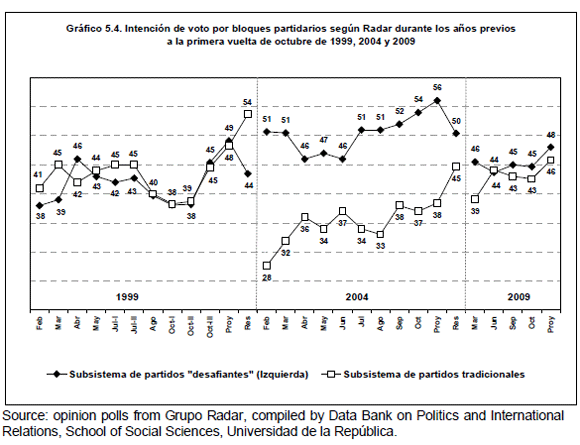
1 According to Sartori's definition of "moderate pluralism" in his classic book on party systems (1992), this kind of party system implies a bipolar logic; therefore, the definition of a party system as "bipolar moderate pluralist" would be redundant. According to Sartori (1992: 225): "... a system of moderate pluralism is characterized by: i) a relatively small ideological distance among its relevant parties; ii) a configuration of bipolar coalition; iii) centripetal competition." However, we underscore that the logic of the Uruguayan party system – or "mechanics" to use a sartorian term – places it closer to a two-party system than to a "moderate pluralism", despite its current "format". For that reason, we prefer to classify the party system that emerged from the 2004 election (which will probably be consolidated in its format and dynamics after the next election) as a two-party system, like other colleagues (Buquet 2005), or – at risk of being redundant – as "bipolar moderate pluralist".
2 Sustaining that the traditional parties shape the two "wings" of a single party block does not mean stating that they are no longer independent parties, with their own organic structures and – maybe more importantly – with some differences in programmatic terms.
3 The figures on vote intention for the Left among young people in 1984 (38.6%) comes from the following calculation: in 1984 there were approximately 544 thousand youngsters between 18 and 29 years old (National Institute of Statistics) of which approximately 93.7% had voted – estimation that comes from comparing the total population older than 17 against the total amount of votes in that election – that is, 510 thousand voters. If 61,4% had voted for the Left, as it happened in Montevideo (Gónzalez 1993: 182), the FA would have had 313 thousand votes in that group, in addition to 12.5% of 60-year-old voters who voted (438 thousand) that is to say, 55 thousand votes. This would leave only 33 thousand votes, out of 401 thousand gained by FA, to be attributed to people between 30 and 59 years old who voted (984 thousand) 3% of the total of those votes, which does not seem a reasonable estimation. While 46.5% of the voters who voted in 1984 lived in Montevideo (González 1993: 22) it can be estimated that out of the 510 thousand young voters who finally voted in that election, also 46.5% lived in Montevideo (237 thousand voters). If of those 237 thousand voters, 61.4% voted for FA (146 thousand out of the 297 thousand the district got, that is, almost 1 out of 2 FA voters in the capital city) then FA was overrepresented among the youngest voters in Montevideo by 1.82 with relation to the percentage of votes the district had (33,65%). While FA had 10.34% of the votes in the interior, it could be estimated that 18.8% of youngsters in that area voted for the Left, applying the overrepresentation factor observed in Montevideo, 51 thousand of the 273 thousand votes corresponding to the age range in the interior of the country (510 * 0,535 * 0,188). To summarize, in the elections of 1984, out of 510 youngsters between 18 to 29 years of age that voted, approximately 197 thousand voted for the Left. This means that, in such age range, - and probably in the subgroup between 18 and 22 years old– in all the country the vote intention for FA – and probably the final electoral behavior – was around 38,6% ((197 / 510) * 100 = 38.6%).
4 To estimate vote intention for FA among the 60 or more year-old voters in all the country using data from a poll carried out in Montevideo, the same procedure as for the young was used, which allows to estimate in 7.8% vote intention for FA in that age range.
5 Nevertheless, the electorate's demographic renewal can only assume explanatory value in relation to the growth of the Left if it is associated with another process, recently analyzed by local political science: the greater capacity of FA families to transfer their party preferences from one generation to another, compared to the "blanco" or "colorado" families.
6 Between 2000 and 2004, according to data provided by the National Office for Migration from the Ministry of Interior, 94 thousand people exiting the country every day, which implies an average migratory movement of approximately 19 thousand people a year; mostly, 18 year-old people or older and, thus, voters (a bit more than 60 thousand).
7 Translator's note: the term "nacionalista" is used as a synonym of "blanco".
8 The estimation of CDN (total and for each party block, in each electoral period) is adjusted according to the real growth of votes cast between elections.
9 The figure of 1125 thousand votes the Left had in 2004 represents around 49% of the total votes cast on 25 October 2009, due to the – modest – growth of the electoral body between the two elections.
10 Another way to express this estimation is the following: of the 1125 thousand the FA had in 2004 (which represent 49% of the total votes cast on 25 October 2009) approximately 70 thousand died or emigrated between that election and the last (3% of the total votes cast in 2009). This represents a reduction of vote turnout to 1.055 thousand votes (46% of the votes cast in 2009). Around 150 to 155 thousand votes would be added to that vote turnout – from youngsters who vote for the first time – (which represent 6.6% of the total votes cast in 2009). To summarize, if the FA had kept all its voters – living and non emigrants – from 2004 (46%), it would have reached – together with the new voters (6.6%) – between 52.5 and 52.6% of the total votes cast. However, the FA had 48% of the votes cast, which implies a difference of 4.5 to 4.6% of votes out of the total votes cast, which did not vote FA in the last election, but had done so in 2004..
11 Coalition composed of small groups, sectors and actors identified with possitions of radical Left, which mostly correspond to groups that split from the FA during the last interelectoral period. Asamblea Popular obtained 0.67% of the total vots cast in the election of 25 October 2009.
12 With the exception of a relatively positive balance registered by PC between the elections of 1994 and 1999.
13 The erosion produced by its first period in Office, unsatisfied expectations in some sectors of the electorate, the characteristics of electoral competition, the profile of the programmatic and electoral supply, other parties' capacity to attract voters, etc.
14 A bit more than 100 thousand votes, approximately 4.6% of the total votes cast.
15 Naturally, some of these voters could also have voted blank or null.
16 Independently from the consideration of those voters, mostly as a "captive" sector for FA in the event of a ballotage.
17 If the PN's candidate is elected, his party would not have absolute majority and therefore the potential cycle towards a "dominant" party system would have been interrupted..













